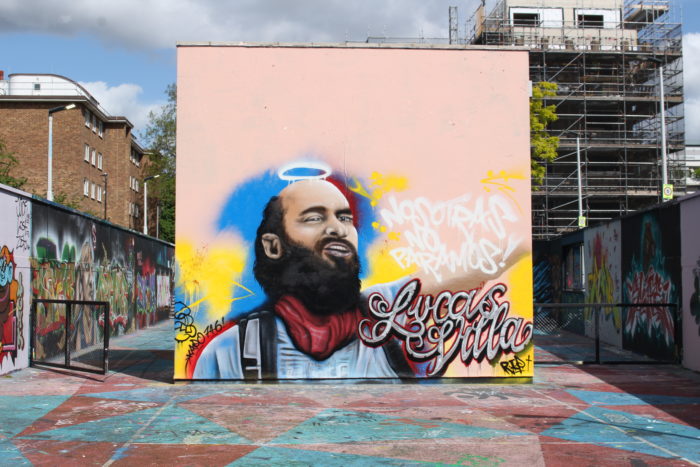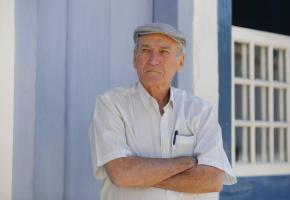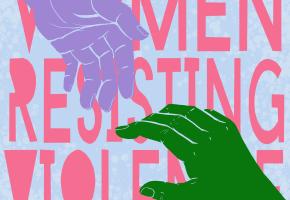A mural by street artist Kapo in London’s Stockwell Hall of Fame was painted in honour of one of the many protestors killed in Colombia during the national strike of 2021. ‘We needed to express what Lucas Villa means to us,’ the organizers say.
Lucas Villa was one of the thousands of demonstrators in Colombia who took to the streets on 28 April 2021 to protest a tax reform proposed by the right-wing government of Iván Duque that would have hit hardest the working classes, the poor, and the unemployed. The police–instead of protecting civilians and allowing the peaceful protest to take its course–responded with violence, further angering demonstrators who took to the streets in larger numbers. Soon the tax reform proposal was withdrawn with the aim of ending the protests, but these evolved into a national strike which lasted for three months.
Lucas Villa became an important figure during these protests, and an inspiration due to his warm and colourful personality. He stood out from the crowd in the many photos and videos shared online during the strike. This made him a target. On the night of 5 May 2021, Villa was walking with two students in the streets of Pereira after a long day of protest, when two motorcycles carrying four men in civilian clothes approached them. One man dismounted and shot at them, fatally wounding Villa who died six days later, on 11 May, in hospital.

The mural, painted by Kapo in famous legal graffiti spot, Stockwell’s ‘Hall of Fame’. Photo: Silvia Rothlisberger
Numerous videos showed the police, controversial riot police ESMAD, and the army violently attacking protestors–in 43 cases with fatal consequences. The footage of Villa showed him peacefully shaking hands with ESMAD, marching with protestors, dancing capoeira, and speaking on buses to raise awareness of the issues that young people are facing in Colombia and their reasons for protesting. Another video pertinently shows Villa shouting at the camera, ‘They are killing us in Colombia’.
The mural in Stockwell was commissioned by a collective of Colombians in the UK who came together in response to the social uprising in Colombia.
‘We decided to do a mural because we needed to express what Lucas Villa means to us. Lucas is the average Colombian who believes in change and who believes that together we can make Colombia a better place. We’re tired of the Colombian government’s lies, corruption and killings, we are not scared any more. They killed Lucas Villa to intimidate the people and make them give up protesting but it didn’t work,’ says Paula Mendez, one of the spokespersons of Pacto Historico Reino Unido. The group come together under this name because they support the Pacto Historico coalition whose presidential candidate is Gustavo Petro and vice-president Francia Márquez.
Colombia’s right-wing president Iván Duque tweeted the day Lucas Villa died saying he condemned the act and that those responsible would ‘face the full weight of the law’ but a year on, no arrests have been made, no results have been shared from the investigation, and Villa’s family are still looking for answers. There is much suspicion of police involvement given that just a few days before the attack, the mayor of Pereira, Carlos Maya, delivered a speech where he asked civilians to join forces with the police and the military to stop protestors.
Lucas Villa’s life has become an important symbol for the protestors who found community, meaning, and immediacy in the streets of Colombia. His death epitomizes the state violence with which the protesters were met. Paula Mendez explains:
‘We decided to honour our brother Lucas Villa one year after his killing because we are still standing and he lives in each one of us who believes we can bring about change together. Lucas Villa sent a text message to his cousin the night before he was shot saying “We can all die here, but how can one abandon the people” – that is how every single young man and woman that took to the streets felt.’
London-based street artist Kapo demonstrates that social mobilization doesn’t end in Colombia. He said of the mural:
‘I want to use my art for a good cause. I want to help by raising awareness, educating more people about the situation in Colombia. You don’t know what might happen, someone might be inspired to do something: someone might donate money for the street kitchens or they might go to Colombia and volunteer and try to help somehow. The things that are happening there are unbelievable. Here in London you have a protest and the police might hit people, but they are not going to shoot people. That would never happen here.’
The protests fuelled a desire for social change in Colombia, but will this materialise in the way people vote in the upcoming presidential elections on 29 May?
This article was first published in by the Latin America Bureau. For more great articles about politics and culture in Latin America visit www.lab.org.uk



















